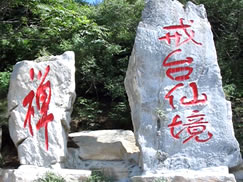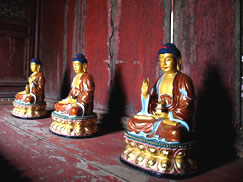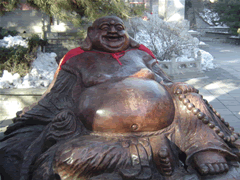JIETAI TEMPLE

Jietai Temple is located at the foot of the Maan Mountain in Mentougou District, west suburb of Beijing. With an altitude of 300 meters, the temple is facing east and covers an area about 4.4 hectare. All the construction were built along the mountain, scattered but well arranged. While at Jietai Temple, one could see the lofty and splendid temple with north features, and also could feel the quiet and elegant sentiment of Jiangnan gardens. The temple boasts strong colors of religious culture and beautiful natural views. Through the long history, Jietai Temple has become a renowned Buddhist temple in China as well as a famous tourist resort.
 Jietai Temple was first built in Kaihuang period of Sui dynasty (582-600). It has already had a long history of more than 1,400 years. Its old name was Huiju Temple. While at Ming dynasty, emperor Yingzong obliged a new name of Wanshou Buddhist Temple. Since the temple has the largest ordination altar (jietai) around the world, which has got the name about the first altar under the sun, so it was commonly called Jietai Temple. And the ordination altar in Jietai Temple, which was built in Xianyong period of Liao dynasty, is known as one of the three largest ordination altars in China together with the altars in Zhaoqing Temple of Hangzhou and Kaiyuan Temple of Quanzhou.
Jietai Temple was first built in Kaihuang period of Sui dynasty (582-600). It has already had a long history of more than 1,400 years. Its old name was Huiju Temple. While at Ming dynasty, emperor Yingzong obliged a new name of Wanshou Buddhist Temple. Since the temple has the largest ordination altar (jietai) around the world, which has got the name about the first altar under the sun, so it was commonly called Jietai Temple. And the ordination altar in Jietai Temple, which was built in Xianyong period of Liao dynasty, is known as one of the three largest ordination altars in China together with the altars in Zhaoqing Temple of Hangzhou and Kaiyuan Temple of Quanzhou.
 Jietai Temple has long been famous for its ordination altar, rare pines and ancient caves. It has lots of ancient trees with peculiar shapes and high viewing values. As early as Ming and Qing dynasty, ten rare pines have already well known around China. And those trees are the best witness for the flourish and downfall of the temple in thousand of years. Mountain behind Jietai Temple has limestone structure. And many beautiful natural limestone caves have come into being through erosion of water in hundreds of millions years. The caves have become a fairyland with various strange and beautiful stalagmites and stalactites. Part of the caves have once repaired by people and built into the Grotto Temple, which used as the place for the hierarchs religious retreat.
Jietai Temple has long been famous for its ordination altar, rare pines and ancient caves. It has lots of ancient trees with peculiar shapes and high viewing values. As early as Ming and Qing dynasty, ten rare pines have already well known around China. And those trees are the best witness for the flourish and downfall of the temple in thousand of years. Mountain behind Jietai Temple has limestone structure. And many beautiful natural limestone caves have come into being through erosion of water in hundreds of millions years. The caves have become a fairyland with various strange and beautiful stalagmites and stalactites. Part of the caves have once repaired by people and built into the Grotto Temple, which used as the place for the hierarchs religious retreat.
Outside the temple, many historical and culture relics including the Buddhist scriptures and stone inscriptions in the cliffs, stone toriis, grave pagoda forest and many mysterious caves were scattered around the temple. Plus with abundant charming natural views and colorful traditional folk customs, Jietai Temple is an ideal tourist destination for visitors.




